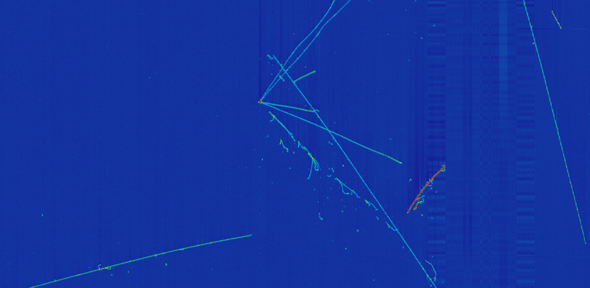A neutrino event candidate in the MicroBooNE detector. Credit: MicroBooNE
An international team of scientists at the MicroBooNE physics experiment in the US, including researchers from the University of Cambridge, detected their first neutrino candidates, which are also known as 'ghost particles'. It represents a milestone for the project, involving years of hard work and a 40-foot-long particle detector that is filled with 170 tons of liquid argon.
Neutrinos are subatomic, almost weightless particles that only interact via gravity or nuclear decay. Because they don't interact with light, they can't be seen. Neutrinos carry no electric charge and travel through the universe almost entirely unaffected by natural forces. They are considered a fundamental building block of matter. The 2015 Nobel Prize in physics was awarded for neutrino oscillations, a phenomenon that is of great important to the field of elementary particle physics.
"It's nine years since we proposed, designed, built, assembled and commissioned this experiment," said Bonnie Fleming, MicroBooNE co-spokesperson and a professor of physics at Yale University. "That kind of investment makes seeing first neutrinos incredible."
Following a 13-week shutdown for maintenance, Fermilab's accelerator complex near Chicago delivered a proton beam on Thursday, which is used to make the neutrinos, to the laboratory's experiments. After the beam was turned on, scientists analysed the data recorded by MicroBooNE's particle detector to find evidence of its first neutrino interactions.
Scientists at the University of Cambridge have been working on advanced image reconstruction techniques that contributed to the ability to identify the rare neutrino interactions in the MicroBooNE data.
The MicroBooNE experiment aims to study how neutrinos interact and change within a distance of 500 meters. The detector will help scientists reconstruct the results of neutrino collisions as finely detailed, three-dimensional images. MicroBooNE findings also will be relevant for the forthcoming Deep Underground Neutrino Experiment (DUNE), which will examine neutrino transitions over longer distances.
"Future neutrino experiments will use this technology," said Sam Zeller, Fermilab physicist and MicroBooNE co-spokesperson. "We're learning a lot from this detector. It's important not just for us, but for the whole physics community."
"This is an important step towards the much larger Deep Underground Neutrino Experiment (DUNE)", said Professor Mark Thomson of Cambridge's Cavendish Laboratory, co-spokesperson of the DUNE collaboration and member of MicroBooNE. "It is the first time that fully automated pattern recognition software has been used to identify neutrino interactions from the complex images in a detector such as MicroBooNE and the proposed DUNE detector."
Provided by University of Cambridge























